The Planet Venus

Venus is often called the twin planet to Earth because 1) it has a similar radius/size, 2) is has a similar mass, 3) it has a similar density and 4) it has an atmosphere. However, the environment of Venus is very different from the Earth.
It also has the somewhat unusual property of
rotating extremely slow (once per 243 Earth days)
such that 1 Venusian day is longer
than a Venusian year (225 Earth days). Even more suprising is that Venus spins in the opposite direction. That is, the Sun rises in the west and sets in the east. There are two differing theories explaining these orbital properties.
1)The slow rotation
is a consequence of billions of years of tidal forces operating on the dense atmosphere causing
the rotation rate of the atmosphere to slow down with time. In turn, the frictional drag
exerted by the atmosphere onto the surface, slows the overall planetary rotation
down to a crawl.
2)Venus may have been hit by a large planetesimal causing the anomalous rotation.
Venus does have a slight orbital tilt indicative of some early event.
Observing Venus
The main problem with probing Venus is simply that its completely covered with
clouds and a very thick atmosphere so that its surface is completely obscured.
The Soviet Union's Venera 8 and 9 missions (1975) represent the only landings on the Venusian surface.
As the Venusian surface is fairly hostile (temperature ~ 450 Farenheit, atmospheric
pressure 90 times
greater than Earth, constant sulfuric acid rain), these spacecraft did not function long.
But they did get a few pictures of the base of the spacecraft and a bunch of rocks:



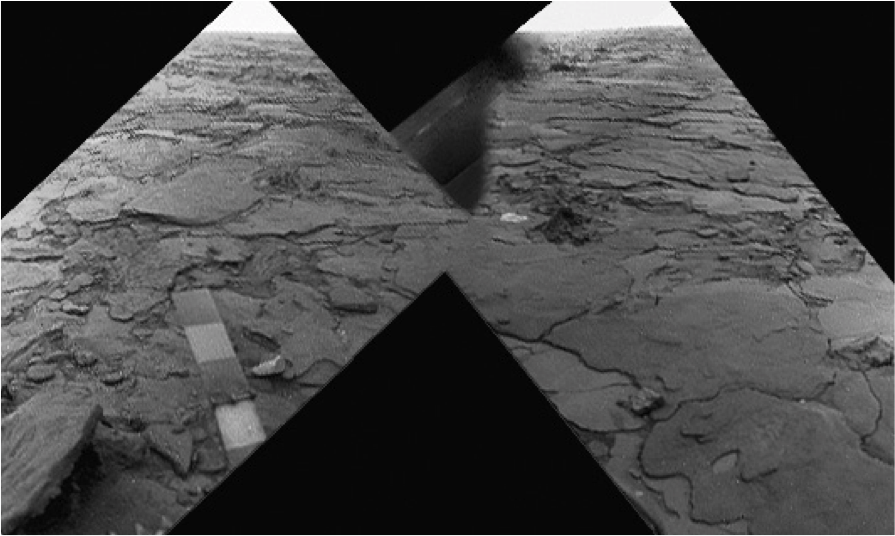
However, radar can penetrate this atmosphere and return a map of topographic
features. Radar mapping works by sending a pulse of radio waves that bounce off surface
features.
Differences in radar timing at different locations represent different elevations. For
instance, a pulse bouncing off a large mountain would take less time to return to the
space craft than a pulse bouncing off a low valley floor.
In this way radar imaging can build up a topological map of Venus.
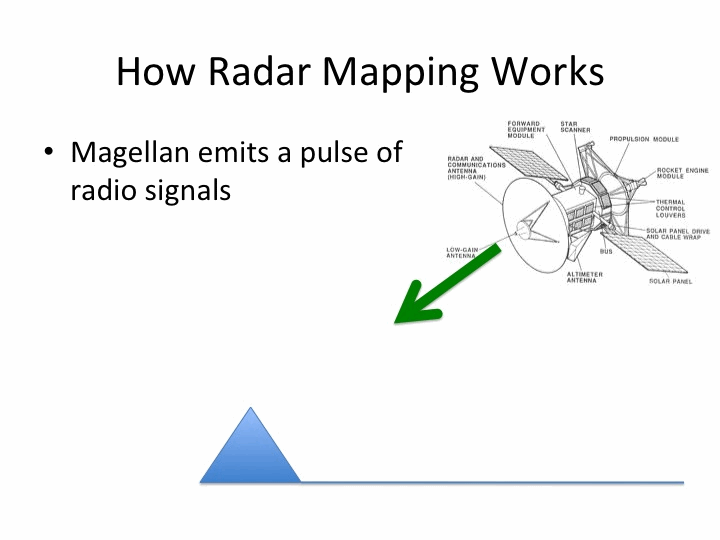
Much of our knowledge of Venus is now based on such data as gathered
by the The Magellan Mission to Venus
The radar mosiac is shown below. The effective resolution of this image is about 3 kilometers. It was processed to improve contrast and to emphasize small features, and was color-coded to represent elevation.
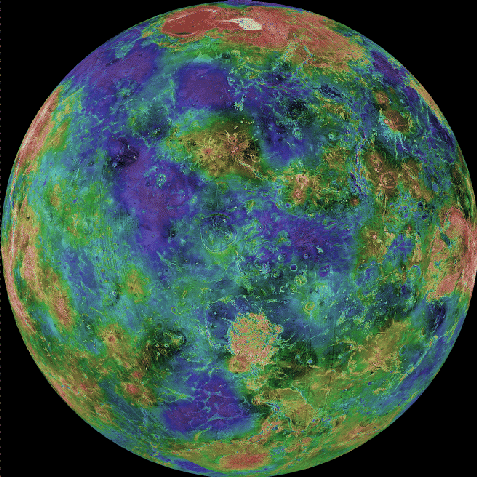
The overall geological and structural features of Venus are the following:
- Its density is 5.2 g/cc meaning that it must also have a
nickel-iron core.
- The core is surrounded by
a substance similar to the Earth's mantle. The crust of Venus appears to be thicker
than the Earth's crust.
- There is a substantial atmosphere on venus, with average atmospheric pressure about
90 times higher than the Earth's. The surface temperature of Venus is around 890 degrees
F, the hottest average temperature in the Solar System.
This is due to a runaway greenhouse effect (see bottom of page for greenhouse effect discussion)
. The atmosphere of Venus is composed of 97%
CO2, 2% N2 and less than 1% of O2, H2O and CH4 (methane). Since CO2
is a major greenhouse gas, the radiation from the Sun is trapped in the atmosphere of Venus producing an extremely high surface temperature.
- There is clear evidence of impact craters - though the actual density of craters shows
that Venus has a relatively young surface and many of the older craters have been
eroded away:

- Substantial vulcanism exists with some volcanoes appearing like tectonic volcanoes
lineup (e.g. the Hawaiian Islands). The image below shows a good example of a chain
of shield volcanoes:
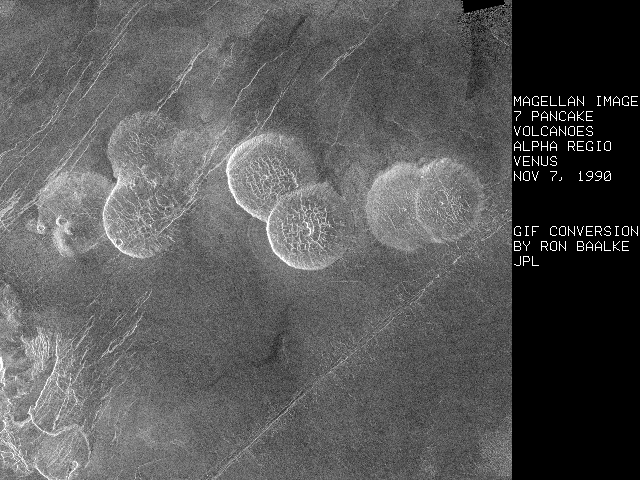
- However most volcanoes are randomly distributed on the surface
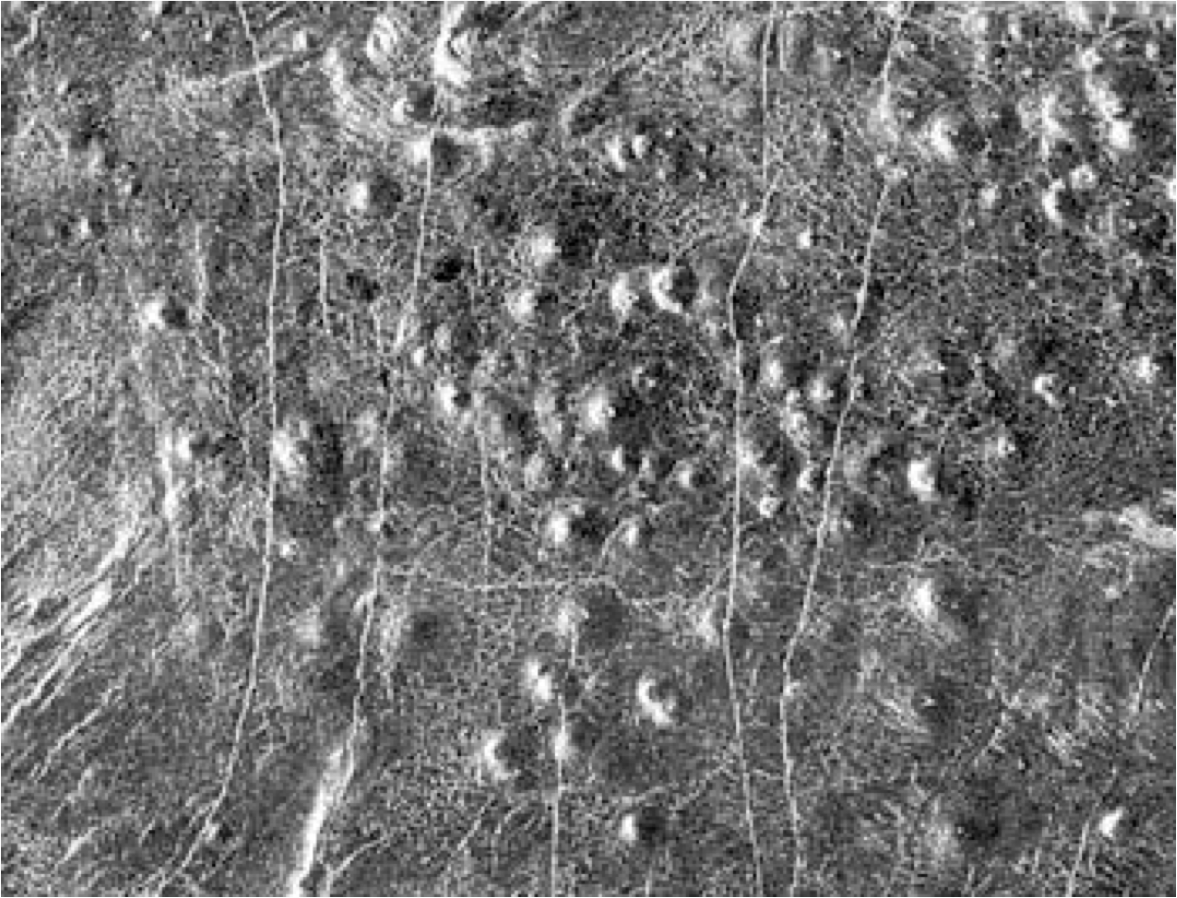
- Wind erosion and dunes:


- Venus has an impressive array of fault lines. In the image below, the bright terrain is a series of troughs, ridges, and faults that are oriented in many directions. The lengths of these features generally range from 10 kilometers to 50 kilometers.
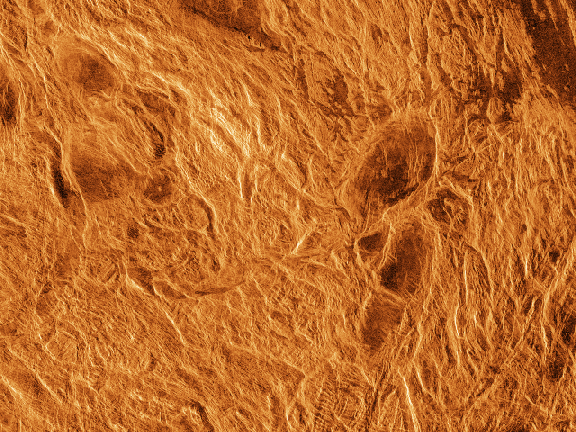
- Venus also has some strange surface features known as arachnoids.
As the name suggests, arachnoids are circular to ovoid features with concentric rings and a complex network of fractures extending outward. The arachnoids range in size from approximately 50 kilometers to 230 kilometers in diameter. They might have resulted from an upwelling of magma from the interior of the planet which pushed up the surface to form "cracks".
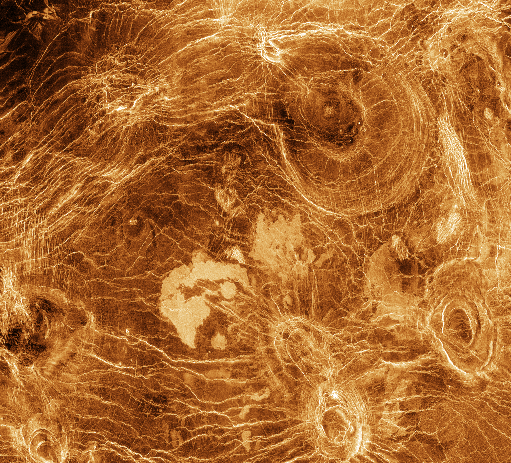
- Although Venus appears to have some "tectonic" features (like continents, fault lines
and linear
chains of volcanoes) there is no strong
evidence for any global plate tectonics like the Earth or
current volcanic activity.
Based on the various radar data and resulting surface features, we can provide the following
quick synopsis of Geology on Venus:
- There are no regions on Venus with saturated impact sites although there are some regions of fairly high crater density
- The surface is clearly young and active geology may be still be occurring. Some estimates are that lava flows data as recently as 300-500 million years ago but this is mostly conjecture.
- There are large scale uplifted regions above lower lying regions. The hemispheric topographic maps strongly support the idea that Venus has been involved in some kind of continent building activity.
- There are features that look like large shield Volcanoes and giant calderas.
- Radar Bright features associated with large craters may be reflective of an explosive volcanic event that has locally shattered the crust.
- The magnetic field is extremely weak and the lack of global tectonics point to
a cooled and solidified interior. How can this be if the Venus is roughly the same
size and density as the Earth? One theory is that 1/2 billion years ago the planet underwent a massive global
volcanic event which released enough energy to resurface the planet as well as cool the
interior and make the crust brittle. No liquid outer core means no magnetic field.
Plate tectonics
requires semi molten rock underlying the surface crust so that the plates move freely. But if the interior is solid neither process can occur.
Natural Greenhouse effect
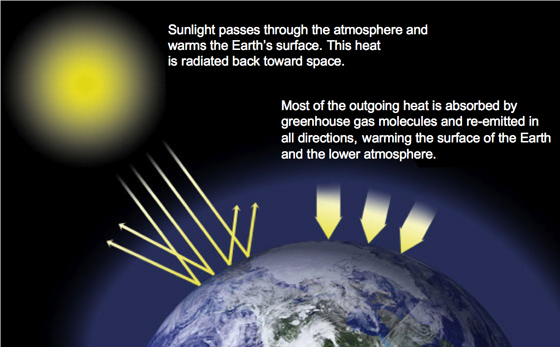 The natural greenhouse effect keeps our planet warm and habitable. Here is a simple
description of the process:
The natural greenhouse effect keeps our planet warm and habitable. Here is a simple
description of the process:
- Sunlight strikes the Earth, some of the light is reflected back from cloud tops.
About 1/2 of
the light makes it to the surface.
- Light that makes it to the surface is absorbed by the Earth and
re-radiated as heat or Infrared light (yes, heat is another wavelength of light)
- Greenhouse gases in the atmosphere (water vapor, methane, carbon dioxide and
nitrous oxide) absorb infrared light and re-radiate it in all directions, keeping some of
the heat trapped and warming the Earth.
Runaway Greenhouse effect
More greenhouse gas means greater heat retention and greater temperature.
If surface temperature rises to the boiling point of water (212 degrees F), any
water on a planet surface will now become water vapor and in turn increase the
greenhouse effect and temperature even more. This is a runaway effect - when greater temperatures increase the amount of greenhouse gases and in turn increase the temperature even
more causing oceans boil off faster, increasing the amount of greenhouse gas in the atmosphere...etc. The story doesn't end with water. At sufficiently high temperatures, carbon dioxide is released from rocks again adding to the atmosphere.
Since Venus is closer to the sun, it receives more sunlight than the Earth. The initial
conditions could have been that it was too hot for water to remain liquid simply because
of Venus' proximity to the Sun. Coupling this with the amount of carbon dioxide already
present in the early atmosphere set up perfect conditions for a runaway effect.















